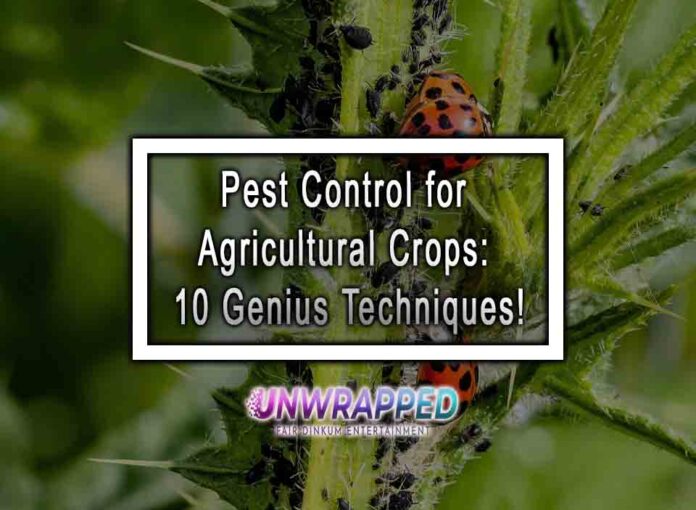Defend Your Crops: Top 10 Pest Control Methods!
Are pesky pests wreaking havoc on your beloved agricultural crops? Don’t let those critters feast on your hard work! We’ve got your back with a compilation of 10 tried-and-true pest control techniques that will keep your crops thriving and pest-free. From natural remedies to cutting-edge innovations, these methods will ensure you harvest a bountiful and healthy yield. Let’s dive into this bug-busting journey!
1. Halt the Invasion: Crop Rotation
Outsmart those cunning pests by practicing crop rotation! Instead of planting the same crop in the same location season after season, mix it up. By changing the type of crops you plant each season, you disrupt pest breeding and feeding cycles, effectively reducing their numbers. Not only does this method deter pests, but it also promotes soil health and nutrient balance, leading to stronger and more resilient crops for future harvests.
2. The Tiny Ninjas: Beneficial Insects
Unleash the power of Mother Nature’s tiny defenders – beneficial insects! Ladybugs, praying mantises, lacewings, and parasitic wasps are just a few of the superheroes that prey on crop-eating pests. Introduce these allies into your fields to naturally control pest populations without resorting to harmful chemicals. These tiny ninjas will feast on pests like aphids, caterpillars, and mites, leaving your crops unscathed and thriving.
3. Say “No” to Harmful Chemicals: Organic Pest Control
Embrace eco-friendly pest control methods by opting for organic solutions. Avoid harsh and harmful chemicals that not only kill pests but can also harm beneficial insects and contaminate the soil and water. Neem oil, garlic spray, and diatomaceous earth are just a few examples of non-toxic alternatives that target pests while preserving the environment and safeguarding beneficial organisms. Organic pest control is a win-win for both your crops and the planet!
4. Fences and Barriers: Keeping Pests at Bay
Build a sturdy fortress around your crops using fences and barriers. These physical deterrents create a formidable obstacle for pests, preventing them from feasting on your precious produce. Consider using chicken wire, row covers, and scare tape to create an effective barrier against crawling and flying pests. Not only do these barriers protect your crops, but they also add a rustic charm to your farm!
5. Heightened Senses: Trap Crops
Redirect pests away from your main crops by planting trap crops nearby. These sacrificial plants attract pests more than your valuable crops, acting as a decoy to protect your primary harvest. For example, if aphids are causing trouble in your lettuce bed, plant some nasturtiums nearby. Aphids are drawn to nasturtiums, keeping them away from your lettuce. It’s like offering a gourmet feast to keep unwanted guests away from the main banquet!
6. Lights Out, Pests!
Believe it or not, some pests are attracted to light sources, disrupting their natural behavior. You can capitalize on this by using special insect traps that emit light to lure pests away from your crops. Install these traps strategically around your fields to create a tempting distraction for pests. Once they are drawn towards the light, they’ll be trapped, and your crops can grow undisturbed in the darkness.
7. Tech-Savvy Defense: Drones and AI
Embrace the future of pest control with drone technology and artificial intelligence! Drones equipped with advanced imaging systems can detect pest infestations early, allowing you to take swift action. AI-powered algorithms can analyze data to optimize pest control strategies, making it a game-changer for modern farmers. Stay one step ahead of those pests with these cutting-edge tools and ensure the health and vitality of your crops.
8. The Power of Nature: Companion Planting
Make your crops less appealing to pests by practicing companion planting. Certain plant combinations create a natural deterrent, masking scents and deterring pests from settling in your fields. For instance, planting marigolds alongside tomatoes can fend off aphids and nematodes. Similarly, basil planted near cucumbers can protect them from unwanted pests. Unlock the power of nature’s partnerships to keep your crops safe and thriving.
9. Biopesticides: Targeted Pest Attack
Bid farewell to indiscriminate chemical pesticides and opt for biopesticides instead! These naturally occurring substances target specific pests while sparing beneficial insects. It’s like sending an elite squad to battle pests without any collateral damage. Neem-based products, Bt (Bacillus thuringiensis) sprays, and insecticidal soaps are examples of biopesticides that target pests effectively, making them a valuable addition to your pest control arsenal.
10. Stay Ahead with Monitoring and Early Action
Prevention is the best cure! Regularly monitor your crops for early signs of pest infestations. Inspect leaves, stems, and fruits for any unusual damage or insect activity. By catching the invaders early, you can implement targeted actions such as handpicking pests, introducing beneficial insects, or applying organic sprays, and prevent minor issues from escalating into major problems that could threaten your harvest.
Champion Crop Protectors – Wrangling Pests Like a Pro!
Congratulations, crop defenders! You’re now equipped with 10 expert-approved pest control techniques to ensure your agricultural crops thrive and flourish. From ancient practices like crop rotation to cutting-edge technologies like drones and AI, there’s an arsenal of options at your disposal. Embrace sustainable and eco-friendly methods to protect your crops, maintain a healthy ecosystem, and savor the sweet taste of victory when you harvest your bumper crops. Happy farming!
Check this: Tick Infestation Dangers: 10 Terrifying Risks You Must Know










